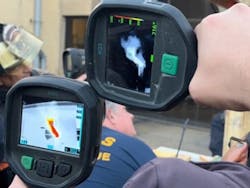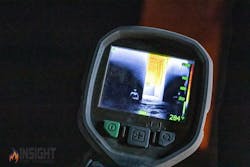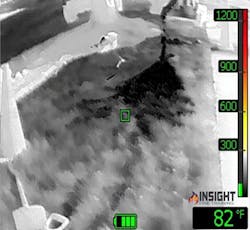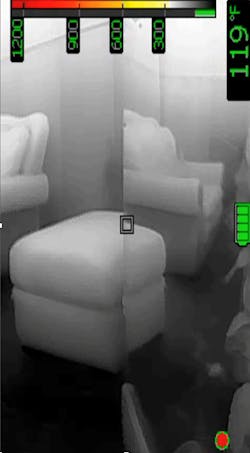The fire service is, let’s say, on fire with education, resources and training. There never has been such a wealth of learning opportunities for everyone to gain more knowledge and understanding. However, one area of education and training continues to receive very little attention. This is the area of thermal imaging, despite the fact that we are in the midst of the greatest time of technological improvement regarding thermal imaging. Furthermore, a 2020 survey that was conducted by Firehouse Magazine shows that thermal imaging usage on the fireground isn’t improving:
- 25 percent of respondents received no thermal imaging training in the year that preceded the survey
- 23 percent weren’t aware of NFPA 1408: Standard for Training Fire Service Personnel in the Operation, Care, Use, and Maintenance of Thermal Imagers
- 40 percent of respondents noted that their thermal imaging training was limited because of restrictions on live fire training
- 58 percent of respondents indicated that they received less than one hour of training from the distributor from which their department purchased a thermal imaging camera (TIC)
- 42 percent of respondents indicated that they didn’t know the difference between a situational awareness TIC and a decision-making TIC
Based on this data, it should be no surprise that thermal imaging often is misunderstood, misinterpreted and/or not applied properly. What follows are, so to speak, the seven deadly sins of TIC use.
1) Failure to understand your TIC
Many firefighters receive little to no training on TICs, and when they receive a newer model, this problem perpetuates itself. To put it simply, we don’t know what we don’t know.
Fire service TICs aren’t all the same. Situational awareness TICs and decision-making TICs vary dramatically in performance and refresh rate. Furthermore, none of these various models perform identically. They vary in the following criteria:
- Temperatures at which colorization is displayed
- Temperature modes—from single-gain, to dual-gain, to tri-mode sensitivity, to mixed-gain
- Required pixel count for switching from high sensitivity to low sensitivity
- Refresh rate—from 25 hertz (Hz) to 60 Hz in decision-making TICs
- Field of view dimensions
- Resolution quality
- Application modes and color palettes
2) Spot temperature vs. entire environment
TICs are divided into two general categories: quantitative and qualitative. Quantitative TICs are designed for more exact measurements and are used in industrial, medical and numerous other applications. However, fire service TICs are qualitative TICs, which are designed to look for anomalies, not exact measurements.The 2021 edition of NFPA 1801: Standard for Thermal Imagers for the Fire Service removed the spot temperature from the startup application mode that’s known as TI Basic because of the many problems that this measurement caused. Although I applaud this improvement, it must come with education on the reason why it was removed. Firefighters have been injured and killed and rekindles have been caused by incorrectly interpreting the image when reading the spot temperature instead of the entire environment.
3) Using a TIC to ‘see gases’
Fire service TICs see a specific wavelength of long-wave infrared radiation (IR). (Long-wave IR is found between 7–14 microns.) However, they don’t see gases or smoke temperatures accurately.
Long-wave IR passes through smoke, which allows the TIC to detect infrared radiation (IR) that’s emitted from surfaces and the temperature differences between the heat source and the end user. In other words, TICs are tremendously valuable for seeing heat, locating fire, locating victims and providing situational awareness, but they don’t see everything. Thus, the actual environment is much hotter than the TIC shows.Because of variables that can’t be accounted for in an emergency response, such as emissivity, atmospheric attenuation and distance to the target, the readings of a TIC might vary dramatically. It’s imperative that the end user be well trained in the proper interpretation of the environment with the TIC.
This is demonstrated when we firefighters attempt to identify a leak from a liquid propane gas tank or a natural gas line. A fire service TIC might see the effects of gases but won’t see the gases themselves. Specialized cameras that are used in the oil and gas industry, which are known as optical gas imaging cameras, are used in this context.
4) Failure to wipe lens
Firefighters often report that their TIC “whited out” shortly after they made entry into the fire environment. When discussed further, the following commonalities emerged: Most of the firefighters were standing up, and they failed to wipe the lens of the TIC.
The front of the TIC has a lens that can accumulate moisture, particulate and other debris as a firefighter moves through the fire environment. This accumulation blocks or limits IR from entering the lens. This will produce a gray/white image that has little to no discernible detail, which renders the TIC useless.
We advocate that as firefighters wipe their facepiece, they also should wipe the lens of the TIC.
Firefighters who fail to wipe the lens of their TIC limit their ability to identify potential victims, because victims often blend in with the background. This leads to the next deadly sin.
5) Victim identification with a TIC
In many departments, live fire training often is restricted and is limited to a minimal number of events per year. Yes, the use of smoke machines and heated targets (specifically, rescue manikins) has become more prevalent. However, there’s a critical issue with training firefighters this way. Firefighters who never rescued a victim while they use a TIC will perceive a victim will be “white hot” in a fire because of their experiences in training.
Victims who are alive in a super-heated environment present either as dark or gray on the TIC display, because their skin/surface temperature is much lower than the fire environment. Victims who have been deceased for some time in a fire environment are a passive emitter, which means that they absorb energy but don’t emit it on their own. They either will blend in with the background or, eventually, heat up, depending on their proximity to the heat source.
The overall background temperature of the environment, the body temperature of the victim (alive or deceased) and the sensitivity mode of the TIC (whether it’s in high or low sensitivity) all contribute to how the victim presents on the display of a fire service TIC.
6) Overreliance for orientation
Although a TIC can be a tremendous asset for well-trained, fundamentally sound firefighters, it also can be a detriment to those who rely on it too much.
Any electronic device is prone to failure, but devices that are placed in such extreme environments as the fireground are even more prone to failure.Firefighters can become disoriented when they focus on the TIC without orienting themselves to the infrastructure, hoselines, doors/windows or search ropes.
Firefighters also can become disoriented when they are in an environment that has many reflective surfaces. Reflective, or low-emissivity, surfaces, such as mirrors, glass and stainless steel, can reflect IR energy back to the TIC.
7) Scanning & standing high
In most fire service thermal imaging training courses, firefighters are instructed to start their TIC scan high, then scan middle heights and then the lower areas. The issue with this methodology?
Firefighters are taught to look for life, fire and layout when they view the fire environment, and a firefighter who scans the fire environment high first won’t see life on the ceiling. However, this most likely will cause the TIC to switch to low sensitivity because of the amount of heat that’s within the field of view. Detail in the colder regions diminishes or disappears, so a firefighter could miss critical information, such as the location of a victim, who typically is located four feet or lower, or a hole in the floor.Therefore, it’s more advantageous to scan low, then middle and then high, because the TIC will begin the scan in the cooler environment, most likely will be in high sensitivity, and will allow firefighters to see more clearly.
Overcoming erroneous use
Although this article isn’t a comprehensive list of all of the errors, or “sins,” of TIC use on the fireground, it does provide a list of the repeat offenses that are mentioned to our training cadre on a regular basis. Each sin can be corrected with proper training, proper interpretation and demonstration of the concepts in a live fire environment. In this manner, the firefighter can fully understand these areas of failure and how to overcome them.
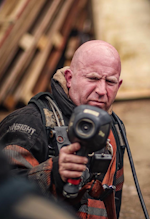
Andrew Starnes
Andrew Starnes has been involved with the fire service as a volunteer since 1992 and as a career firefighter since 1998. He retired as a battalion chief and 25-year career with a large career department in North Carolina. Starnes is Level II Thermography Certified and is the founder of Insight Training LLC, which developed the first thermography-based firefighter certification that's credentialed through Infrared Training Center. He is a fire service website contributor on the topics of thermal imaging, fire behavior, leadership, behavioral health and faith-based devotions. Starnes has trained and/or assisted departments with thermal imaging training in all 50 states and in numerous other countries.
